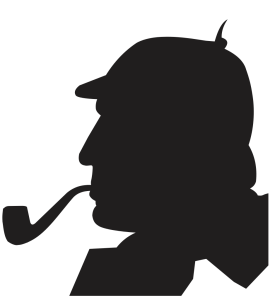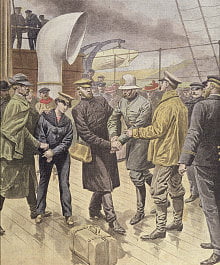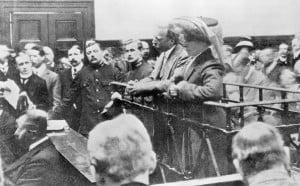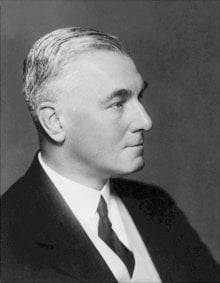If there ever was an incarnation of the legendary Sherlock Holmes, it would undoubtedly be Bernard Henry Spilsbury, the medical detective. He did more for the advancement of forensic medicine than any man in history, particularly in the application of the science in its legal context to the criminal courts of justice.
Through a highly eventful and fulfilling medical career, Spilsbury found, or maybe created, time for full-fledged Masonic activity in several Lodges and Orders. Coincidentally, some of the accused involved in his cases were also Freemasons. Sadly, he suffered personal tragedies and the added burden of the repugnant actions of others finally led him to take his own life on 17 December 1947.
Bernard Spilsbury, born in Bath in January 1877, could trace his family association with medicine as far back as the late 17th century. His disciplinarian father, James Spilsbury, and his churchgoing mother, Marion Joy of Stafford, moved to Leamington in 1876, where their four children were born.
Bernard was the eldest and destined to become a doctor, not least because it was the wish of his father – and his father was a strong-willed man. With his brother Leonard and sisters Constance and Gertrude, Bernard was tutored until the age of 12, when the family moved to London. He went to Leamington and then Owens College and is recorded to have been ordinary in sport and mediocre in his academic studies.
He grew to become a handsome man, more than six feet in height, quiet and cheerful and always well dressed. In 1893 he was admitted to Magdalen College, Oxford to read Natural Science in preparation for his entry in 1899 to St Mary’s Hospital Medical School. His father’s gift of a new microscope led Bernard to switch from general practice to pathology, and he never looked back.
Forensic medicine at this time was not only in its infancy, but still treated with suspicion and even contempt by the medical and legal fraternity. Three key men, all doctors at St Mary’s Hospital, were the pioneers and founding fathers of the new science: Dr A P Luff, William Wilcox and A J Pepper. It was this group that Bernard Spilsbury joined and with them wrote history in this particular field of medical discipline.
It was two years after his marriage to Edith Thorton that Spilsbury took on the mantle of chief pathologist at St Mary’s from his mentor, Dr Pepper. Now well-known in the medical community, it was the Crippen case in 1910, a landmark in forensic medicine, that made him a household name.

Hawley Harvey Crippen was born in Michigan in 1862 and came to England as a doctor in 1907. He was hanged at Pentonville Prison on 23 November 1910 for the murder of his wife, Kunigunde Mackamotzi, who went by the name of Belle Elmore. Early that year Belle had disappeared. Crippen’s mistress, Ethel le Neve, who was seen wearing Belle’s clothes and jewellery, overtly and shamelessly took her place. To enquirers as to the whereabouts of his wife, Crippen claimed she had returned to the United States.
Following the rumours of Belle’s disappearance, the pair fled on the SS Montrose to Canada, Ethel le Neve disguised as a boy. When the police returned to search their house, they found mutilated remains of a body hidden in the basement. Telegraphic despatches with descriptions of the fugitives led to the arrest of the couple on 31 July 1910 – the first such arrest with the use of the new wireless system.
The couple were separately accused and tried at the Old Bailey and Crippen was found guilty. Ethel le Neve was acquitted. Bernard Spilsbury’s evidence, extracted only from a piece of skin from the victim’s belly, was instrumental evidence in the conviction of Crippen. More important, Spilsbury’s demeanour as he gave evidence through the trial impressed his many colleagues. His official status as police pathologist in England was established.

He was celebrated for his evidence at many sensational murder trials, which were popularised by their headline titles: The Brides in the Bath and the Brighton Trunk Murders among many others. Meanwhile, Spilsbury continued his lectures and tutorship at St Mary’s until he had a minor dispute with a colleague who had been impolite. Spilsbury took umbrage and demanded an apology, which was refused. The dispute was brought before the Court of Governors, who totally exonerated Spilsbury, but it was too late and, with considerable reluctance, Spilsbury resigned and left St Mary’s Hospital in 1920.
He was received with enthusiasm – as he would have been at any hospital – as lecturer on Morbid Anatomy and Histology at St. Bartholomew’s hospital. Although the move to Bart’s did not change his busy routine of lectures, demonstrations and assistance to coroners and the police, he now joined the Craft.
He had previously resisted invitations by his many fellow doctors to become a Freemason. It may have been the change of environment and an awareness of the antiquity of Bart’s, the oldest hospital in England, that may have induced, maybe inspired him at the relatively late age of 44, to do so and he took to Freemasonry with enthusiasm.
On 15 June 1920 he was initiated into Rahere Lodge No. 2546, named after the founder of St. Bartholomew’s priory and hospital in 1123. In October he was passed and later made a Master Mason on 10 May 1921. He was elected and served as Master of the Lodge in 1932. By then he had become a Royal Arch Mason, exalted into Rahere Chapter on 8 March 1922 with equal enthusiasm and served as First Principal in 1937. This was only part of his extensive Masonic involvement. On 3 May 1923 he was advanced in the Mark Degree at Abernethy Mark Lodge, then No. 722, consecrated in 1920 as a medical Mark Lodge associated with Barts. He was installed as Master on 24 November 1933.
In 1936 the Lodge amalgamated with Sir Joseph Dimsdale Lodge No. 569 and, rather unusually, took on the earlier number, retaining its own name. He also joined both Sancta Maria Lodge No. 2682 and St. Mary Magdalen Lodge No. 1523. He progressed to become Master of both Lodges. The former Lodge was founded on 15 November 1897 to celebrate Queen Victoria’s Jubilee and consisted entirely of medical staff and students.
Spilsbury became Master in May 1941, the year of the tragic death of his son Peter, who had been initiated in Apollo University Lodge No. 357, Oxford, and who was also a member of St Mary Magdalen Lodge. This Lodge was founded in 1874 and consisted of members of Magdalen College, Oxford who had moved to London. On 21 December 1923 Spilsbury was informed that a knighthood would be conferred on him in the New Year’s Honours list. It was a well-deserved recognition.
Meanwhile, his Masonic career progressed with equal success. In 1935 he was appointed to Grand Rank as a Past Junior Grand Deacon. Supreme Grand Chapter made him a Grand Officer in 1939 when he was appointed Past Assistant Grand Sojourner. It is not clear why he joined both the Chapter and Lodge of Friendship No. 6, in that order, in 1939 and 1940 respectively. He resigned from both in March 1946.

Among the thousands of cases in which Spilsbury participated, two are of particular Masonic interest. In the trial of Herbert Rouse Armstrong for murder, an extraordinary number of the key participants were Freemasons. Let it be emphasised that Freemasonry played no part whatsoever in any of the proceedings and is mentioned merely as a coincidental factor.
Altogether ten of the individuals concerned in the case happened to be members of the Craft. Herbert Armstrong, an English solicitor – the only known solicitor to be hanged for murder – was at the time a Past Master of Loyal Hay Lodge No. 2382 in Herefordshire. He was brought to trial in 1922 for the murder of his wife Katharine and the attempted murder of Oswald Martin.
Curiously, Armstrong would have got away with his first crime but for the attempted poisoning of his rival solicitor Martin, a fellow member of the same Loyal Hay Lodge. When suspicion of attempted poisoning fell on Armstrong, his wife’s body was exhumed and traces of arsenic were found by Spilsbury, who had only become a Master Mason in May of that same year. Dr Wilcox and Dr Webster, who were the additional pathologists who gave evidence, were both Freemasons as was Hincks, the doctor who had treated Mrs. Armstrong during her last illness.

Armstrong had claimed to have purchased arsenic in order to make his own weed killer. The ever-increasing quantities of arsenic were purchased from the local pharmacist, Bro J F Davies, Martin’s father-in-law, who alerted the police as to his suspicions. Davies had resigned from the Loyal Hay Lodge in 1899.
Judge Darling, who presided at the main court hearing, was not a Freemason. John Hurd, however, the witness at the Assize hearing, and Tunnard Moore, chairman of the Bench at the magistrate’s court hearing, as well as William Rees, the foreman of the jury, all belonged to Loyal Hay Lodge. Armstrong was found guilty of the murder of his wife and hanged on 31 May 1922. He had had a successful Masonic career by any standards. Bro. E H Cleese, who was in the same solicitors’ practice as Oswald Martin, introduced him to Loyal Hay Lodge in Hay-on-Wye in 1906. Armstrong served as Master in 1912, Chaplain in 1920 and was appointed a Past Provincial Senior Grand Deacon for the Province of Herefordshire in 1921.

The second case involving a Freemason is here being considered out of chronological sequence because of its greater significance to Freemasonry. It is the well-known case of Frederick Henry Seddon, who was tried, convicted and subsequently hanged at Pentonville Prison on 18 April 1912 for the murder of his lodger, Miss Eliza Mary Barrow. On being asked by the clerk of the court if he had anything to say as to why the sentence of death should not be passed against him, Seddon replied at length and appealed to the judge, as a brother Mason and in the name of ‘The Great Architect Of The Universe’ for a reversal of the jury’s finding.
According to some sources, he gave the First Degree sign, begging for mercy. Judge Bucknill, a prominent Freemason, is recorded to have said, with some emotion:
[highlight] It is not for me to harrow your feelings – try to make peace with your maker. We both belong to the same Brotherhood, and though that can have no influence with me this is painful beyond words to have to say what I am saying, but our brotherhood does not encourage crime, it condemns it.[/highlight]
Then he pronounced the sentence of death. Spilsbury, very much a key player in seeing justice done, was still a young practitioner and not yet himself involved in Freemasonry. His colleagues who provided forensic evidence, however, were Masons.
Dr William Henry Wilcox, medical adviser to the Home Office who, as already mentioned, was a member of the Craft, having been initiated on 13 March 1906 in Sancta Maria Lodge, of which Spilsbury was later to become a joining member. So was Dr John Webster, senior official analyst to the Home Office, initiated on 8 June 1909.
The Seddon case remains one of considerable controversy. Aged 40 at the time of his trial, Seddon was seen to be an avaricious man whose only motive for the cruel murder of Eliza Mary Barrow was financial gain. He was accused of poisoning her with arsenic obtained from fly strips. The case against him was weak and depended almost entirely on the evidence of Spilsbury, whose expertise even this early in his career was instrumental and impressive.
The trial Judge, RW Bro Thomas Townsend Bucknill, Provincial Grand Master for Surrey from 1903 to 1915, was initiated in 1873 in Lodge of Good Report No. 136. As to Frederick Seddon, he was initiated in Stanley Lodge No. 1325, Liverpool, in 1901 and resigned a year later to travel south. In 1905 he is named as a founding petitioner of Stephens Lodge No. 3089, Bourne End in Buckinghamshire. He resigned from both Lodges in 1906.
As successful as his career had been, Spilsbury faced tragedies through his life. In 1940 he suffered a stroke and this was the start of the decline in his health. He had the shocking experience of hearing of his son’s death by way of a note of condolence from a colleague and not knowing which of his two sons had been killed.
It was his son Peter, whose passing was announced without comment in open Lodge on 3 February 1941, the meeting at which Bernard Spilsbury was elected Master. It is said that Spilsbury was a changed man thereafter. He lost the spring in his walk and there was a marked decline in his mental alertness. He was a man fatigued and worried with the continuous pressure of unwholesome work. It finally led to his taking his own life on 17 December 1947. His remains were cremated at the Golders Green crematorium.
Bernard Spilsbury’s standing as a staunch supporter of truth and justice, those special Masonic characteristics, and as the greatest forensic doctor of all time, will never be erased from memory.
Bibliography & credits
Ashby, John F, Death and the Freemason, AQC 108:11
Browne, N E & Tullett E V, Bernard Spilsbury: His Life and Cases, London 1951
Dewhurst T L, St Mary Magdalen Lodge No. 1523: 1875-1975
Wright, John, Sancta Maria Lodge No. 2682 1897-1997 – A Short Centenary History
Young, F, The Trial of the Seddons, AQC (1914) 108:27n;
Young, F, The Trial of H.R. Armstrong, AQC (1927) 27n
Also Bros Gordon Bourne, Michael Pugh, Bob Calderan, Zivanovic Srboljub, Trevor Dutt and, as ever, John Hart, for their helpful assistance
